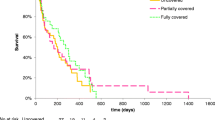Abstract
Background
Covered or uncovered self expandable metallic stents (SEMS) placed in patients with malignant biliary obstruction can occlude in 19–40 %, but optimal management is unclear.
Aim
We sought to summarize current evidence regarding management of occluded SEMS in patients with malignant biliary obstruction.
Methods
Two investigators independently searched Pubmed, Embase, and Web of Science using pre-defined search criteria, and reviewed bibliographies of included studies. Data were independently abstracted by two investigators, and analyzed using RevMan. We compared strategies of second SEMS versus plastic stents with respect to the following outcomes: rate of second stent re-occlusion, duration of second stent patency, and survival.
Results
Ten retrospective studies met inclusion criteria for the systematic review. Management options described were placement of an uncovered SEMS (n = 125), covered SEMS (n = 106), plastic stent (n = 135), percutaneous biliary drain (n = 7), mechanical cleaning (n = 18), or microwave coagulation (n = 7). Relative risk of re-occlusion was not significantly different in patients with second SEMS compared to plastic stents (RR 1.24, 95 % CI 0.92, 1.67, I2 = 0, p 0.16). Duration of second stent patency was not significantly different between patients who received second SEMS versus plastic stents (weighted mean difference 0.46, 95 % CI −0.30, 1.23, I2 = 83 %). Survival was not significantly different among patients who received plastic stents versus SEMS (weighted mean difference −1.13, 95 % CI −2.33, 0.07, I2 86 %, p = 0.07).
Conclusions
Among patients with malignant biliary obstruction and occluded SEMS, available evidence suggests a strategy of placing a plastic stent may be as effective as second SEMS. Limitations of these findings were that all studies were retrospective and heterogeneity between studies was detected for two of the outcomes.





Similar content being viewed by others
References
Davids PH, et al. Randomised trial of self-expanding metal stents versus polyethylene stents for distal malignant biliary obstruction. Lancet. 1992;340:1488–1492.
Kaassis M, Boyer J, Dumas R, et al. Plastic or metal stents for malignant stricture of the common bile duct? Results of a randomized prospective study. Gastrointest Endosc. 2003;57:178–182.
Knyrim K, Wagner HJ, Pausch J, et al. A prospective, randomized, controlled trial of metal stents for malignant obstruction of the common bile duct. Endoscopy. 1993;25:207–212.
Moss AC, Morris E, Leyden J, et al. Do the benefits of metal stents justify the costs? A systematic review and meta-analysis of trials comparing endoscopic stents for malignant biliary obstruction. Eur J Gastroenterol Hepatol. 2007;19:1119–1124.
Moss AC, Morris E, Mac Mathuna P. Palliative biliary stents for obstructing pancreatic carcinoma. Cochrane Database Syst Rev. 2006;19:CD004200.
Ahmad J, Siqueira E, Martin J, et al. Effectiveness of the ultraflex diamond stent for the palliation of malignant biliary obstruction. Endoscopy. 2002;34:793–796.
Dumonceau JM, Cremer M, Auroux J, et al. A comparison of ultraflex diamond stents and Wallstents for palliation of distal malignant biliary strictures. Am J Gastroenterol. 2000;95:670–676.
Ferlitsch A, Oesterreicher C, Dumonceau JM, et al. Diamond stents for palliation of malignant bile duct obstruction: a prospective multicenter evaluation. Endoscopy. 2001;33:645–650.
Bueno JT, Gerdes H, Kurtz RC. Endoscopic management of occluded biliary Wallstents: a cancer center experience. Gastrointest Endosc. 2003;58:879–884.
DerSimonian R, Laird N. Meta-analysis in clinical trials. Control Clin Trials. 1986;7:177–188.
Hozo SP, Djulbegovic B, Hozo I. Estimating the mean and variance from the median, range, and the size of a sample. BMC Med Res Methodol. 2005;5:13.
Lee MJ, Dawson SL, Mueller PR, et al. Failed metallic biliary stents: causes and management of delayed complications. Clin Radiol. 1994;49:857–862.
Cho JH, Jeon TJ, Park JY, et al. Comparison of outcomes among secondary covered metallic, uncovered metallic, and plastic biliary stents in treating occluded primary metallic stents in malignant distal biliary obstruction. Surg Endosc. 2011;25(2):475–482.
Katsinelos P, Beltsis A, Chatzimavroudis G, et al. Endoscopic management of occluded biliary uncovered metal stents: a multicenter experience. World J Gastroenterol. 2011;17:98–104.
Ornellas LC, Stefanidis G, Chuttani R, et al. Covered Wallstents for palliation of malignant biliary obstruction: primary stent placement versus reintervention. Gastrointest Endosc. 2009;70:676–683.
Rogart JN, Boghos A, Rossi F, et al. Analysis of endoscopic management of occluded metal biliary stents at a single tertiary care center. Gastrointest Endosc. 2008;68:676–682.
Tham TC, Carr-Locke DL, Vandervoort J, et al. Management of occluded biliary Wallstents. Gut. 1998;42:703–707.
Togawa O, Kawabe T, Isayama H, et al. Management of occluded uncovered metallic stents in patients with malignant distal biliary obstructions using covered metallic stents. J Clin Gastroenterol. 2008;42:546–549.
Yoon WJ, Ryu JK, Lee JW, et al. Endoscopic management of occluded metal biliary stents: metal versus 10F plastic stents. World J Gastroenterol. 2010;16:5347–5352.
Ridtitid W, Rerknimitr R, Janchai A, et al. Outcome of second interventions for occluded metallic stents in patients with malignant biliary obstruction. Surg Endosc. 2010;24:2216–2220.
Maetani I, Ukita T, Inoue H, et al. Microwave coagulation versus insertion of a second stent for occluded biliary metal stent. Hepatogastroenterology. 2001;48:1279–1283.
Gargouri D, Kochlef A, Ouekaa A, et al. Biliary stent occlusion. Tunis Med. 2010;88:462–466 [Article in French].
Acknowledgments
Dr. Shah was supported by an NIH T32 (5T32DK007568—21). Dr. Fisher was supported in part by an ASGE Senior Investigator Mentoring Award.
Conflict of interest
None.
Author information
Authors and Affiliations
Corresponding author
Rights and permissions
About this article
Cite this article
Shah, T., Desai, S., Haque, M. et al. Management of Occluded Metal Stents in Malignant Biliary Obstruction: Similar Outcomes with Second Metal Stents Compared to Plastic Stents. Dig Dis Sci 57, 2765–2773 (2012). https://doi.org/10.1007/s10620-012-2272-7
Received:
Accepted:
Published:
Issue Date:
DOI: https://doi.org/10.1007/s10620-012-2272-7




